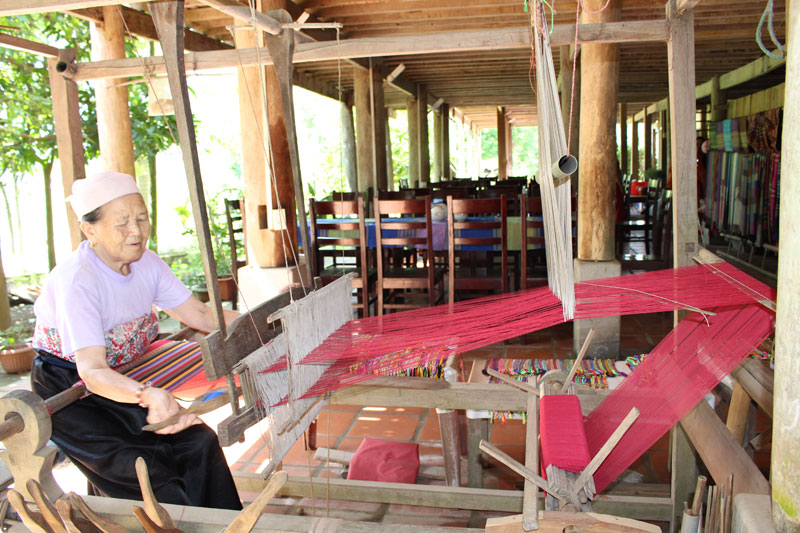
(HBO) - Mai Chau town of Mai Chau district (Hoa Binh province) has made concerted efforts to preserve and promote typical cultural features of the Thai ethnic minority group, said a local official.
According
to Ha Van Quang, Vice Chairman of the town’s People’s Committee, the town is
currently home to 12 amateur art troupes. Vibrant public art movement has drawn
the participation of a crowd of local people. Performances of velvety Thai
ethnic melodies extolling the town’s beauty received first prizes at the
district’s art contests.
Mai Chau town has joined hands with lcoal schools to set up art troupes and
encourage students to sing Thai ethnic songs, helping them fully grasp the values
of Thai ethnic language and raise sense of responsibility in protecting the
values.
Folk games of the Thai ethnic minority group have been integrated into
extracurricular activities at schools while the Thai language is used in
families every day.

Brocade
weaving has been preserved and developed by local people in Mai Chau town for
years.
The Thai ethnic minority group’s
tradition has been practiced through numerous festivals like Xen Ban, Xen Muong
and Com Moi (new rice). Preparing worship trays, making traditional dishes and
inviting powwows to carry out rituals show their respect for traditional
values.
Mr. Ha Van Thiet in Pom Coong village said: "My ancestors once performed Thai
traditional rituals and now we have to obey the practice to set example for our
descendants”.
The new rice festival is among typical festivals maintained by the Thai ethnic
people in Mai Chau town. The festival, held after the 8th lunar
month when all families finish their rice harvest, is an occasion for Thai
people to give thanks to their ancestors for a bumper crop. It also helps
educate younger generations about gratitude and respect for their parents and
ancestors.
Meanwhile, images featuring Thai women sitting next to their looms to weave
brocade have become their fine tradition. Currently, the town has 18 brocade
weaving establishments. Engrossed in making scarves, bags and gowns, Thai
ethnic women want to teach their children about responsibility to take care of
their families.
In Mai Chau town, Thai women wear their traditional dresses during special
occasions like festivals, meetings or New Year holidays. Particularly, in
community-based tourism villages of Van and Pom Coong, Thai women have been
encouraged to dress traditional costumes when welcoming tourists.
Stilt houses of the Thai ethnic people have been also preserved. Up to 40 out
of 79 households in Pom Coong village have retained their stilt houses./.
With an increasingly vibrant and widespread emulation movement aimed at building cultured residential areas and cultured families, Yen Thuy District has been making steady progress toward improving both the material and spiritual well-being of its people, while fostering a civilized, prosperous, beautiful, and progressive community.
Once lacking recreational spaces and community facilities, Residential Group 2 in Quynh Lam Ward (Hoa Binh City) has recently received attention for the construction of a new, spacious, and fully equipped cultural house. The project followed the model of state support combined with public contributions in both labor and funding.
The "All people unite to build cultural life" movement, which has been effectively integrated with Kim Boi district’s socio-economic development goals, is fostering a lively spirit of emulation across local residential areas, hamlets, villages, public agencies, and enterprises. In addition, through the initiative, traditional cultural values are being preserved and promoted, while community solidarity and mutual support in poverty reduction and economic development are being strengthened.
A working delegation of the Hoa Binh provincial People’s Committee led by its Permanent Vice Chairman Nguyen Van Toan on June 11 inspected the progress of a project to build the Mo Muong Cultural Heritage Conservation Space linked to tourism services in Hop Phong commune, Cao Phong district.
Born and growing in the heroic land of Muong Dong, Dinh Thi Kieu Dung, a resident in Bo town of Kim Boi district, in her childhood was nurtured by the sweet lullabies of her grandmother and mother. These melodies deeply imprinted on her soul, becoming an inseparable part of her love for her ethnic group's culture. For over 20 years, this love for her hometown has driven Dung to research, collect, and pass down the cultural values of the Muong people to future generations.
In the final days of May, the Ethnic Art Troupe of Hoa Binh Province organized performances to serve the people in remote, mountainous, and particularly disadvantaged areas within the province. These were not just ordinary artistic shows, but they were the meaningful journeys aimed at spreading cultural values, enhancing the spiritual life of the people and contributing to the preservation of ethnic minority cultural identities.



